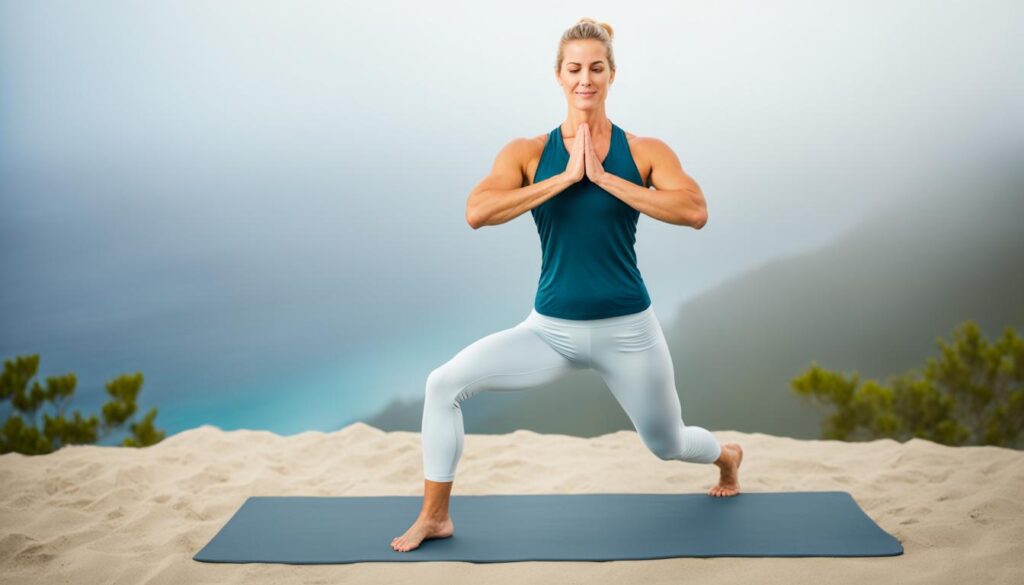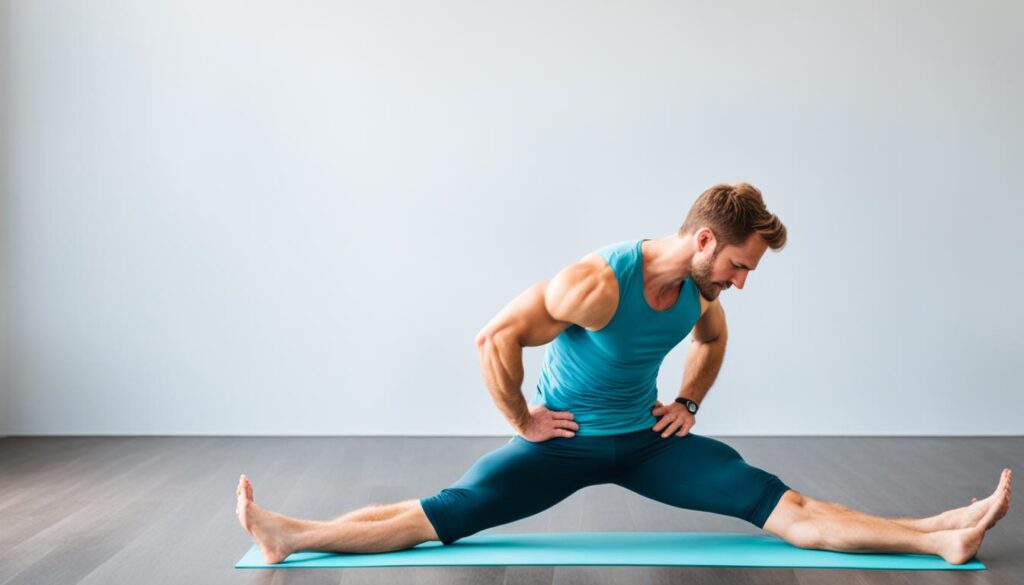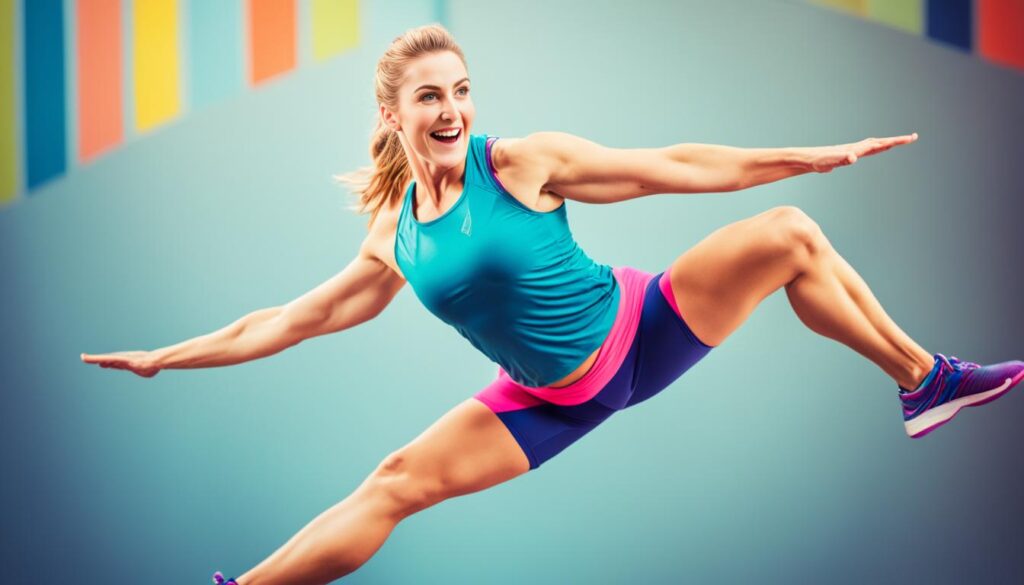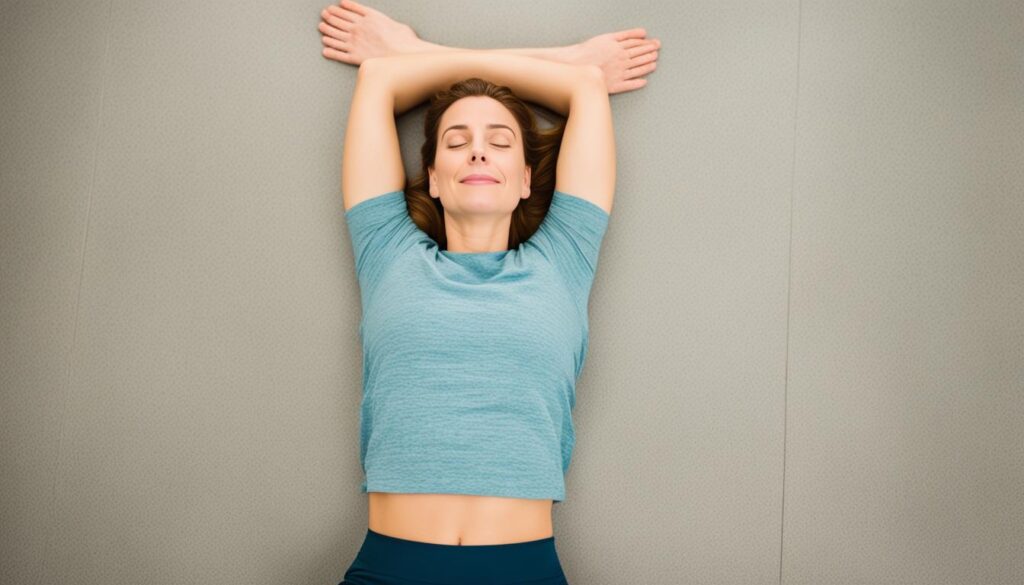Yoga is a powerful tool for well-being. It combines body and mind exercises. For those new to yoga, there are easy poses that help with flexibility and stress.
Poses like Mountain Pose, Child’s Pose, and Cat-Cow Pose are great starts. They’re gentle and easy, ideal for beginners. These poses can be a daily part of your life, helping you start your yoga journey.

Key Takeaways:
- Practicing yoga can improve flexibility and reduce stress.
- Beginner-friendly yoga poses are simple and easy to perform.
- Mountain Pose, Child’s Pose, and Cat-Cow Pose are great poses for beginners.
- Incorporating yoga into a daily routine can lead to overall well-being.
- Start your yoga journey with these beginner-friendly poses at home.
Mountain Pose (Tadasana)
Mountain Pose, known as Tadasana, is a key yoga pose. Stand with feet hip-width apart on the mat. This stance helps with proper alignment and builds a solid base for yoga. It’s great for improving posture and is beginner-friendly.
In Mountain Pose, imagine being as stable as a mountain. Feel your feet connect with the earth, rooting firmly. Engage your legs and lower your tailbone to create a grounding effect. Lift your spine and chest, and relax your shoulders.
While in this pose, breathe slowly and deeply. Let your body find its natural position, aligning your head, neck, and spine. Using a block between your thighs can help with proper alignment.
Mountain Pose is a key starting and ending posture in yoga. It helps focus your mind and ground you. This pose prepares you for a balanced and mindful yoga session.
Child’s Pose (Balasana)
Child’s Pose, also known as Balasana, is a simple yet powerful way to relax. It’s perfect for beginners and offers many benefits. These include calming the mind and stretching the body.
When doing Child’s Pose, you kneel and sit back on your heels. Then, you lean forward until your forehead touches the ground. This stretches your back, shoulders, and hips. It helps release tension and relaxes these areas. Practitioners find peace and comfort in this position during yoga.
This pose is great for those who want to reduce stress and relax. It lets you focus on your breathing and releases tension. Doing so, you can care for yourself and feel rejuvenated.
“Child’s Pose is like a safe haven in yoga. It’s a retreat where you can let go, find solace, and reconnect with yourself.”
Child’s Pose also makes you more flexible, especially around your hips and back. Practicing it often can make these areas more mobile. This helps with daily activities.
You can use Child’s Pose as a break between more active yoga poses. It gives you a chance to catch your breath and prepare for what’s next. This makes your yoga practice more enjoyable.
Now that we’ve seen how great Child’s Pose is, let’s discover another pose. It will also add to your yoga journey.

| Benefits of Child’s Pose (Balasana) | Instructions |
|---|---|
|
|
Cat-Cow Pose (Marjaryasana-Bitilasana)
The Cat-Cow Pose, also known as Marjaryasana-Bitilasana, is great for beginners. It makes the spine flexible and eases back tension. In this pose, you start on all fours. Make sure your hands are right under your shoulders. Your knees should be under your hips.
To do the Cat-Cow Pose, just follow these easy steps:
- Inhale deeply and arch your back, lifting your head and tailbone towards the ceiling. This is known as the cow pose.
- Exhale fully and round your spine, tucking your chin and tailbone towards the floor. This is called the cat pose.
- Repeat the fluid movement, synchronizing your breath with the motions. Inhale for the cow pose and exhale for the cat pose.
This pose stretches and strengthens your spine. It boosts flexibility and eases tension. It’s really good for beginners wanting to make their spines more flexible and relieve back stress.
“The Cat-Cow Pose is a gentle and effective way to warm up the spine and bring awareness to the body’s movements.” – Yoga instructor, Jane Smith
Adding the Cat-Cow Pose to your yoga routine brings many benefits:
- Improved spinal flexibility
- Enhanced posture and alignment
- Release of tension in the back
- Increased body awareness
- Promotion of relaxation and stress relief
Regularly practicing the Cat-Cow Pose helps beginners gain strength and flexibility in the spine. This leads to a healthier, more balanced body.

| Benefits of Cat-Cow Pose (Marjaryasana-Bitilasana) | How to Perform Cat-Cow Pose |
|---|---|
|
|
Downward Facing Dog (Adho Mukha Svanasana)
Downward Facing Dog, or Adho Mukha Svanasana, rejuvenates the body and relieves stress. It’s perfect for people new to yoga and those looking to stretch their bodies. This pose strengthens and stretches your body deeply.
To perform Downward Facing Dog, start with your hands and knees on the mat. Make sure your wrists are under your shoulders and knees are apart. Then, lift your knees, push your hips up, and form an “V” shape.
This pose stretches your hamstrings, shoulders, and spine. It releases tension and promotes flexibility and mobility. Plus, it strengthens your core muscles.
Regularly practicing this pose can help improve your posture and relieve muscle tightness. It lets you connect with your breath, bringing calmness and relaxation.
Benefits of Downward Facing Dog (Adho Mukha Svanasana)
- Provides a full body stretch, targeting the hamstrings, shoulders, and spine
- Strengthens the arms, shoulders, and core muscles
- Improves posture and alignment
- Relieves tension and stress in the body
- Promotes a sense of calmness and relaxation
Add Downward Facing Dog to your yoga routine for a rejuvenating experience. Its many benefits make it a must-have in beginner yoga.

| Difficulty Level | Category | Target Area |
|---|---|---|
| Beginner | Standing Pose | Full Body |
Warrior II (Virabhadrasana II)
Warrior II, also known as Virabhadrasana II, is ideal for yoga beginners. It boosts strength and stability. At the same time, it opens up the hips and chest. This brings a sense of expansion and grounding.
To get into Warrior II, stand at your mat’s front with feet apart. Turn your right foot out, aligning your heel with your left foot’s arch. Bend your right knee so it’s over your ankle, and keep your left leg straight.
Stretch your arms out to the sides, parallel to the floor. Reach forward with your right arm and back with your left. Gaze over your right hand. Feel the power in your legs. Push down through your feet and tighten your core for balance.
Warrior II builds strength, opens hips, and improves balance and focus. It works the legs and tones muscles. Opening the hips also helps release tension, making for better flexibility.
This pose adds resilience and power to your yoga practice. It’s great for beginners needing a strong foundation. It also provides grounding and steadiness for mind and body.
Benefits of Warrior II (Virabhadrasana II)
- Strengthens the legs, arms, and core.
- Improves balance and stability.
- Opens hips and chest, enhancing flexibility.
- Boosts focus and concentration.
- Creates a sense of grounding and inner strength.
Tips for Practicing Warrior II (Virabhadrasana II)
- Align your front heel with your back arch, and keep your knee over your ankle.
- Keep your core engaged for stability.
- Shoulders should be relaxed, away from your ears.
- Choose a focal point to enhance balance and focus.
- Try different arm positions to find what suits you best.
- Breathe deeply and steadily to stay calm and present.
Warrior II is more than a pose. It symbolizes strength, stability, and grace. Awaken the warrior within as you practice.

Now, we’ll look at another key pose. It’s called Triangle Pose, stretching the side body and aiding balance.
Triangle Pose (Trikonasana)
Triangle Pose, or Trikonasana, is a beginner yoga pose that helps both body and mind. It’s great for improving balance and strengthening the legs. A great choice for any yoga routine.
To get into Triangle Pose, start with feet wide apart. Extend your arms to your sides, keeping them level with the floor. Next, hinge at the hips and reach your right hand towards your right ankle. Your left arm goes straight up to the sky.
This pose creates a straight line from your hands to your feet. It offers a deep stretch along your side body. It also helps to lengthen and open muscles around the ribs, waist, and hips. This increases overall flexibility.
Triangle Pose is great for improving balance and stability. The pose’s wide stance and extended arms make you feel grounded. Focusing on keeping the pose helps improve concentration and mental clarity.
With regular practice, beginners can see better strength and flexibility. They’ll also enjoy a sense of calm and equilibrium.

| Benefits of Triangle Pose (Trikonasana) |
|---|
| Improves balance |
| Strengthens the legs |
| Stretches the side body |
| Opens the hips and chest |
| Enhances flexibility |
Bridge Pose (Setu Bandhasana)
Bridge Pose, or Setu Bandhasana, is great for beginners. It gently strengthens the back, glutes, and hamstrings. To do this pose:
- Lie flat on your back with knees bent. Keep your feet flat on the mat, hip-width apart.
- Push your feet into the mat. This engages your glutes and hamstrings.
- Put your hands together under your body. This helps bring your shoulders together. It also opens the chest and shoulders gently.
- Lift your hips using your glutes and hamstrings strength.
- Keep your chin down and neck relaxed.
- Take deep breaths and hold the pose. Feel your back and lower body working.
- Bring your hips back to the mat and let go of your hands.
This pose makes your spine more flexible and strengthens the lower body. It’s perfect for waking up the glutes and hamstrings. Plus, it improves posture and eases back tension.

Tips and Modifications:
Want to get more from Bridge Pose? Try these tips:
- Can’t clasp your hands? Use a yoga block or towel under your back for help.
- For more hamstring stretch, put a block or bolster under your feet. Rest your heels on it.
- If your neck is sore, add a folded towel or blanket under it.
- Don’t forget to pull your navel towards your spine to engage your core.
“Bridge Pose is perfect for beginners. It wakes up the glutes and hamstrings and makes the spine flexible. This gentle backbend also eases tension and opens the chest and shoulders.” – Yoga Instructor
You can add Bridge Pose to a beginner yoga routine. It’s a gentle backbend that activates the glutes and hamstrings. Use it alone or with other poses like Cat-Cow or Downward Facing Dog. This makes for a balanced practice.
| Benefits of Bridge Pose (Setu Bandhasana) | How to Perform Bridge Pose |
|---|---|
|
|
Tree Pose (Vrikshasana)
Tree pose, or Vrikshasana, is great for improving balance and concentration. It also makes your legs stronger. This pose is good for beginners. It requires focus and stability. You can adjust it for your flexibility and balance.
To perform tree pose:
- Start by standing tall with your feet together and your arms at your sides.
- Shift your weight onto your left foot, keeping it grounded and stable.
- Place the sole of your right foot on your inner left thigh or calf, avoiding direct contact with the knee joint.
- Find a focal point in front of you to help with concentration and balance.
- Bring your hands together at heart center, or if you feel steady, extend your arms overhead like the branches of a tree.
- Maintain a steady breath and hold the pose for 30 seconds to 1 minute.
- Repeat on the other side by shifting your weight onto your right foot and placing the sole of your left foot on your inner right thigh or calf.
Tree pose improves both physical balance and mental focus. As you keep your legs and core active, you’ll feel grounded and strong.

Seated Forward Bend (Paschimottanasana)
Seated Forward Bend, also known as Paschimottanasana, is great for beginners. It deeply stretches your hamstrings, spine, and shoulders. This pose helps you relax and become more flexible in both body and mind. Here’s how to do it: sit with your legs straight out in front of you. Take a deep breath in, then lean forward as you breathe out, reaching for your toes. It’s okay to slightly bend your knees or use a yoga strap. This makes the pose doable for everyone.
This pose is perfect for easing tension in your lower back and hamstrings. These areas often get stiff and sore. By doing this pose regularly, you can become more flexible in your hamstrings and spine. Plus, it’s a quiet moment for releasing any stress or tension you’re feeling.
When trying Seated Forward Bend, be patient and pay attention to what your body is saying. You might find you can stretch further with each session. Keep breathing deeply to help with relaxation. Adding Seated Forward Bend, or Paschimottanasana, to your yoga practice can rejuvenate you, both physically and mentally.